Bienvenidos!
While our trade embargo with Cuba still remains in place, restrictions between the two countries have been eased so opportunities now exist to travel to Cuba legally. Tourism is still not permitted, but Americans can travel here via licensed educational exchange trips known as people-to-people tours. These are education-based trips that can only be offered by travel companies that have received a license from the Treasury Department’s Office of Foreign Assets Control – it’s all about the dollars. If you’re eager for more details, see 31 CFR § 515.565(b). And if you’re not down with the latest CFR §, it basically says go, but don’t deal too much with the Cuban Communist Party.
Arrival
The night before departing to Cuba there was an introductory meeting where we met our group, and thankfully no one seemed too annoying. The next morning we hopped on a chartered American Airlines flight, and 45 minutes later landed in Havana. I stepped off the plane onto the runway and took in a deep breath…it smelled ripe with communism. After a very painless checkout through passport control – where the most intrusive question they asked me was “Is this your passport?” to which I replied “Si” – we were ready to explore the country. (And no, that wasn’t Rosetta Stone talking…that’s 12 years of living in Southern California. What’s up.)
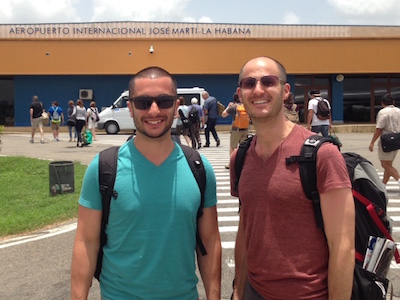
Initial Thoughts
Cuba is a poor country. The impact of both governmental control and the US embargo are noticeable everywhere. Infrastructure in Havana seems developed, but it’s very outdated and dilapidated – clearly a reflection of more prosperous years past. Also, whether a result of the communist regime or simple poverty, it seems there’s almost nowhere to spend money, both for tourists or locals. There aren’t many restaurants, I haven’t seen a single grocery store or corner market, and the one furniture store I saw was empty inside. This may be the first country I’ve visited where it may not be possible to live like a local. It doesn’t help that there are two currencies in Cuba: one for locals (pesos) and one for tourists (the CUC, pronounced “kooks”, or as I like to pronounce, “Cubans”.) Local establishments – if they actually exist – will accept either, but no tourist place will accept local pesos.
Finally, God forbid you forget about Fidel Castro or Che Guevara for even five minutes…their names and faces are everywhere.

Communism
As expected under communism, the government owns most businesses and services, such as hotels, restaurants, and entertainment. The country is actively working to improve its economy by privatizing many of these companies by local and foreign investors, and it was interesting to see common items being owned or produced or run by the government: sodas, nightclubs, clothing, etc. Cuban cola was essentially free; Coca-Cola cost was expensive.
A uniquely communist practice here in Cuba is that of rationing. Every Cuban citizen is given monthly rations, and everyone takes advantage of the program. Rice, beans, toilet paper, rum…most products needed for daily life are included. Old or young, every Cuban received rations their entire life, and the only thing adults got that children didn’t was coffee. Here was a typical ration store. It was far from glamorous, but it was effective.
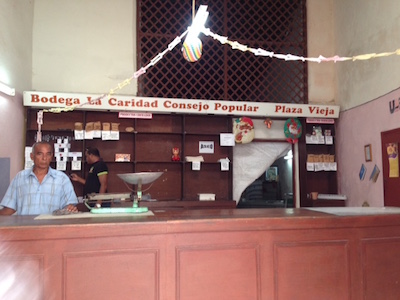
Rationing also affected us tourists in a very real way. Every day we would receive two bottles of water. And even though I toured harder than every other member of our group, I still only received two bottles. It’s tough being a communist.
Cigars
Cuba’s most well-known product and export is the cigar. Producing over 250 different kinds of cigars, Cuban cigars are considered by all to be the highest quality in the world. We had the opportunity to visit their main factory, La Corona. This factory, doesn’t produce just one brand of cigars, but all the top brands – including Cohiba, Montecristo, Romeo y Julieta, and H. Upmann.
And in what turned out to be my saddest moment of the trip, we were told there is a strict no photo policy inside the factory. Feel free to take pictures of their military, airport security, and police…but don’t dare photograph the cigar factory.
So allow me to paint a picture with words. The factory consisted of row after row of the most low-tech technology you could imagine: people sitting at small desks, pulling up one large tobacco leaf after another, and rolling it by hand. After these filler leaves were rolled together, they were put into molds on top of their desk where they were manually pressed for 30 minutes. Then a nicer, wrapper tobacco leaf was rolled around it, creating the final cigar. It was quite impressive watching a messy pile of brown leaves quickly turn into a nearly perfectly symmetric and sealed cigar before your eyes.
The cigar makers work from 7am-3pm daily, producing ~100 per day. On top of their pay they also received 5 free cigars a day. The factory prided themselves them on having a 65% female workforce, because “women are good at organization”.
Even though photos were prohibited, I managed to sneak this one of an empty part of the factory floor. The things I do for you, people…

When in Cuba, do as the Cubans do. Here we are appreciating their finest. I didn’t cough (too much).

Rum
Cuba’s second famous product is rum. Most drinks contain it, and their main brand is Havana Club. And the way Morocco had mint tea and Brazil had caipirinhas, Cuba’s national drink is the mojito…a cocktail made with rum, mint, and sugar. It’s a tasty drink that goes down like water, and before you know it it’s mid-afternoon and you’ve already had 8.
Ernest Hemingway, the writer and America’s most well-known expatriate who lived in Cuba for much of his productive life, frequented the bar below for his favorite mojito in town.
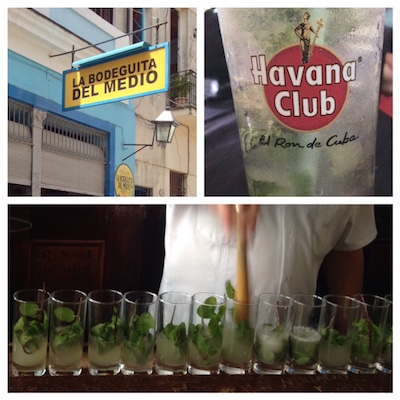
Vintage Cars
To visit Cuba today is to experience a country frozen in 1950. Most notable are their cars. The roads are filled with vintage American cars, including Chevys, Buicks, and Pontiacs from the 1920s-1950s. Most are meticulously maintained and brightly colored. Even better, many were used as taxis.
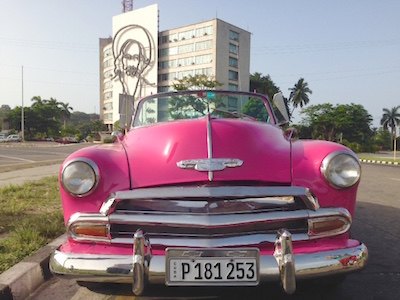
Our taxi one evening, in Revolution Plaza.
Around Havana
Our first day we visited the city cemetery, full of large mausoleums containing the remains of famous and ordinary Havana citizens. Cuban Barack Obama showed us around and pointed out the more popular tombs, including that of Ernest Hemingway’s bartender and Amelia, a woman whose baby survived some great catastrophe and nowadays people visit her tomb to have their wishes granted.

We visited a local organization that acts as a community center for underserved youth to hone their creative skills and perform community service. Cuban Macy Gray charmed everyone with her voice.
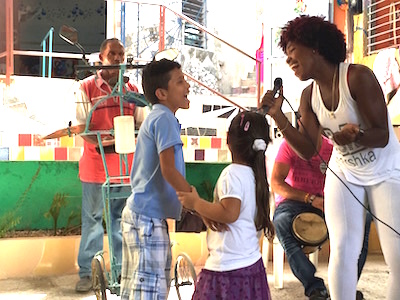
Our final day we were treated to an amazing private show by the Havana Compass dance studio, a private dance company. They made amazing — and amazingly loud! — sounds with their drums, chairs, and sticks. Think of it as Cuban Stomp…but probably better.

Earlier in the week, Cuban Morgan Freeman grabbed me on the street. I thought that was strange and then he put me in a headlock…which was even stranger. We had to give him 2 pesos before he let me go. Sadly no one got a photo of it.
Parting Thoughts
I arrived in Cuba ready to show them how great America is…they could finally learn about affordable healthcare, gay rights, and bald eagles. But after a few days there I learned that despite their terrible economy, Cubans are a remarkably upbeat and happy people. They’re kind and welcoming, and they’re also incredibly talented and passionate in all things artistic and musical (I’ve never heard so much great live music.) There’s certainly a lot we can learn from them. And who knew…they already have affordable healthcare!
As a visitor I never felt threatened roaming around town, even in the middle of the night. Cuba is one of the safest countries in the western hemisphere, and it certainly felt that way. Above all, there were essentially no beggars. Almost never was I approached by someone asking for money…very refreshing. (Hint, hint, Morocco.)
Some countries are communist but still successful, while others have US-imposed sanctions and are (moderately) successful. The combination, however, appears to be the kiss of death. Hopefully each of these aspects will be rectified in the near future and create better opportunities for the Cuban people to prosper.

(By the way, because of this passport stamp, any time I re-enter the US in the future I need to show paperwork proving this visit to Cuba was in fact legal.)
Cuban Barack Obama and Macy Gray. Ha!! Uncanny resemblances. Glad u had a great time. Now off to the next destination…Viva Italiano!!
Mmmmm mojito. Just revisiting your trip waiting for surg. Wishing I had a mojito